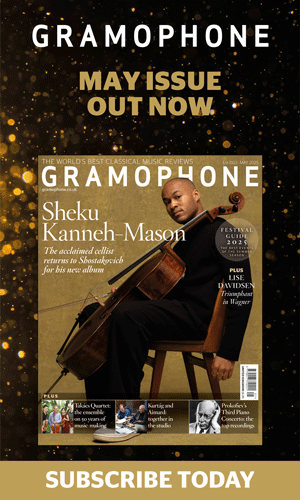A letter from New York: Golijov’s Ainadamar at the Met; Nathalie Joachim’s Had To Be
Andrew Farach-Colton
Friday, January 3, 2025
Golijov’s Ainadamar at the Met; Nathalie Joachim’s Had To Be; William Grant Still’s Symphony No 4, Autochthonous

New York’s autumn concert season is off to a rapturous start, and I mean that quite literally. I felt the first moment of rapture in mid-October at Carnegie Hall in a cogent yet vividly characterised performance of Mahler’s Third Symphony by the Philadelphia Orchestra. Yannick Nézet-Séguin kept things moving – in a good way – so the expansive opening movement seemed to fly by, while the slow finale flowed in a way that felt both natural and right. There was rapture aplenty in the latter movement, of course, but it’s those hushed trio sections of the Scherzo with the posthorn solos that have stuck with me. That rare sense of stillness – like being stopped in one’s tracks by a particularly intense memory – is so difficult to capture, let alone sustain, but Nézet-Séguin and the silver-toned principal trumpet Esteban Batallán did it somehow.
Ainadamar is a difficult work to stage; I left the house convinced that the Met had done Golijov’s brilliantly inventive score justice
A few nights later I made my first trip of the season to the Metropolitan Opera. I was familiar with the score to Osvaldo Golijov’s Ainadamar as I’d sat in on the sessions for DG’s recording (my report was published in the September 2006 issue of Gramophone) and saw Peter Sellars’s staging later that year. This was the Met’s first foray into Golijov’s work, and Joshua Barone wrote in The New York Times that the production didn’t make the opera ‘crackle and smoulder like the Lorca works it so earnestly tries to honor’. I was riveted from the start, however. I’ll admit that of the singers, only tenor Alfredo Tejada’s blood-curdling portrayal of Lorca’s executioner outshone the principals on the recording, but Deborah Colker’s flamenco-drenched production had a powerful cumulative effect, and in the opera’s final third I found myself overwhelmed with emotion, so much so that I occasionally found myself gasping for breath. This was a dark, unsettling sort of rapture, yes, but it was rapturous nonetheless. And while Ainadamar appears to be a difficult work to stage, I left the house convinced that the Met had done Golijov’s brilliantly inventive score justice.
Ainadamar is only the second Spanish-language opera in the Met’s repertoire; Daniel Catán’s Florencia en el Amazonas, produced last season, was the first. Given the city’s enormous Spanish-speaking population, this seems like common sense. Actually, I’ve been heartened to see many of the city’s major musical organisations continue their efforts to represent a broader musical community, and working largely behind the scenes towards greater inclusivity is the Sphinx Organization. Although based in Detroit, this exceptional and enormously effective training programme has a national reach, and the fruits of its labours are on full display in its annual gala at Carnegie Hall featuring the Sphinx Virtuosi, a self-conducted chamber orchestra of young, professional black and Latino musicians.
Not surprisingly, the Sphinx Virtuosi’s repertoire is focused on black and Latin composers. This concert featured an excerpt from Venezuelan pianist/composer Teresa Carreño’s Serenade for Strings (1895), but it was the work of contemporary composers – all of them also relatively young – that grabbed my attention. Derrick Skye’s American Mirror, Part One (a string orchestra arrangement of a work originally for string quartet) bridges traditions from Africa, Eastern Europe and Appalachia(!) in a way that feels completely organic. It’s also just plain gorgeous and – yes, you guessed it – rapturous in its highly ornamented lyricism. In the brief concert-closer Daydreaming, Levi Taylor put a personal spin on Scott Joplin’s music; I only wished it was longer, as Taylor clearly has musical personality to spare. And while I don’t often feel rapture in virtuoso displays, Curtis Stewart’s Double Down, an invention for two violins, had me vibrating in my seat. Violinists Tai Murray and Nijioma Chinyere Grevious’s incendiary performance was cause enough to feel chills, but in the end it was Stewart’s compositional legerdemain that left me slack-jawed. Here’s a composer with a sure sense of theatre, and yet his exhilarating cleverness is as serious as it is fun. (Stewart is no slouch as a violinist, either: check out his recording of Julia Perry’s thorny yet luminous 1968 Violin Concerto, reviewed in the US section of the April 2024 issue.)
The following night, I heard the New York Philharmonic led by Thomas Wilkins in a concert entitled ‘Afromodernism: Music of the African Diaspora’. That programme closed with William Grant Still’s Symphony No 4, Autochthonous (1947), an immediately likeable work that was very belatedly receiving its Philharmonic premiere. Why such a richly tuneful and finely wrought score is so neglected is beyond me, but then the same could be said for any of Still’s symphonies. The evening’s sublime moment of rapture, however, came in the finale of Nathalie Joachim’s Had To Be (2024), a three-movement cello concerto featuring the prodigiously talented Seth Parker Woods. I was spellbound by the entire work, with its references to New Orleans’ second line and Harlem jazz, but after the mesmeric finale, with the soloist’s incandescent ‘poetic incantations’ (in the composer’s words), I felt I was walking on air. When you don’t want a piece of new music to end, you know the composer has done something extraordinary.









